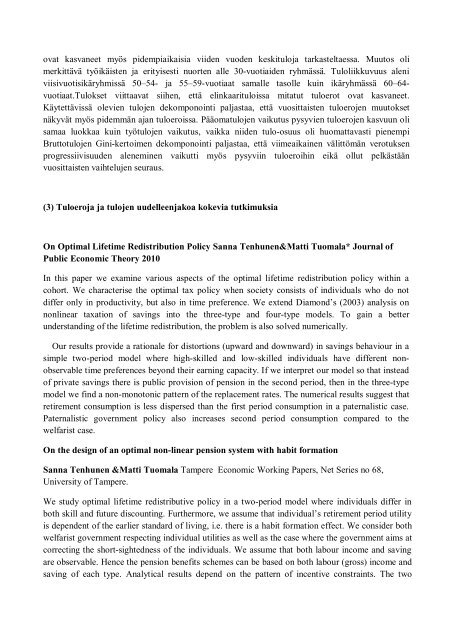Suomen Akatemia VALTA-OHJELMAN HANKKEIDEN TULOKSET
Suomen Akatemia VALTA-OHJELMAN HANKKEIDEN TULOKSET
Suomen Akatemia VALTA-OHJELMAN HANKKEIDEN TULOKSET
Create successful ePaper yourself
Turn your PDF publications into a flip-book with our unique Google optimized e-Paper software.
ovat kasvaneet myös pidempiaikaisia viiden vuoden keskituloja tarkasteltaessa. Muutos oli<br />
merkittävä työikäisten ja erityisesti nuorten alle 30-vuotiaiden ryhmässä. Tuloliikkuvuus aleni<br />
viisivuotisikäryhmissä 50–54- ja 55–59-vuotiaat samalle tasolle kuin ikäryhmässä 60–64vuotiaat.Tulokset<br />
viittaavat siihen, että elinkaarituloissa mitatut tuloerot ovat kasvaneet.<br />
Käytettävissä olevien tulojen dekomponointi paljastaa, että vuosittaisten tuloerojen muutokset<br />
näkyvät myös pidemmän ajan tuloeroissa. Pääomatulojen vaikutus pysyvien tuloerojen kasvuun oli<br />
samaa luokkaa kuin työtulojen vaikutus, vaikka niiden tulo-osuus oli huomattavasti pienempi<br />
Bruttotulojen Gini-kertoimen dekomponointi paljastaa, että viimeaikainen välittömän verotuksen<br />
progressiivisuuden aleneminen vaikutti myös pysyviin tuloeroihin eikä ollut pelkästään<br />
vuosittaisten vaihtelujen seuraus.<br />
(3) Tuloeroja ja tulojen uudelleenjakoa kokevia tutkimuksia<br />
On Optimal Lifetime Redistribution Policy Sanna Tenhunen&Matti Tuomala* Journal of<br />
Public Economic Theory 2010<br />
In this paper we examine various aspects of the optimal lifetime redistribution policy within a<br />
cohort. We characterise the optimal tax policy when society consists of individuals who do not<br />
differ only in productivity, but also in time preference. We extend Diamond’s (2003) analysis on<br />
nonlinear taxation of savings into the three-type and four-type models. To gain a better<br />
understanding of the lifetime redistribution, the problem is also solved numerically.<br />
Our results provide a rationale for distortions (upward and downward) in savings behaviour in a<br />
simple two-period model where high-skilled and low-skilled individuals have different nonobservable<br />
time preferences beyond their earning capacity. If we interpret our model so that instead<br />
of private savings there is public provision of pension in the second period, then in the three-type<br />
model we find a non-monotonic pattern of the replacement rates. The numerical results suggest that<br />
retirement consumption is less dispersed than the first period consumption in a paternalistic case.<br />
Paternalistic government policy also increases second period consumption compared to the<br />
welfarist case.<br />
On the design of an optimal non-linear pension system with habit formation<br />
Sanna Tenhunen &Matti Tuomala Tampere Economic Working Papers, Net Series no 68,<br />
University of Tampere.<br />
We study optimal lifetime redistributive policy in a two-period model where individuals differ in<br />
both skill and future discounting. Furthermore, we assume that individual’s retirement period utility<br />
is dependent of the earlier standard of living, i.e. there is a habit formation effect. We consider both<br />
welfarist government respecting individual utilities as well as the case where the government aims at<br />
correcting the short-sightedness of the individuals. We assume that both labour income and saving<br />
are observable. Hence the pension benefits schemes can be based on both labour (gross) income and<br />
saving of each type. Analytical results depend on the pattern of incentive constraints. The two


